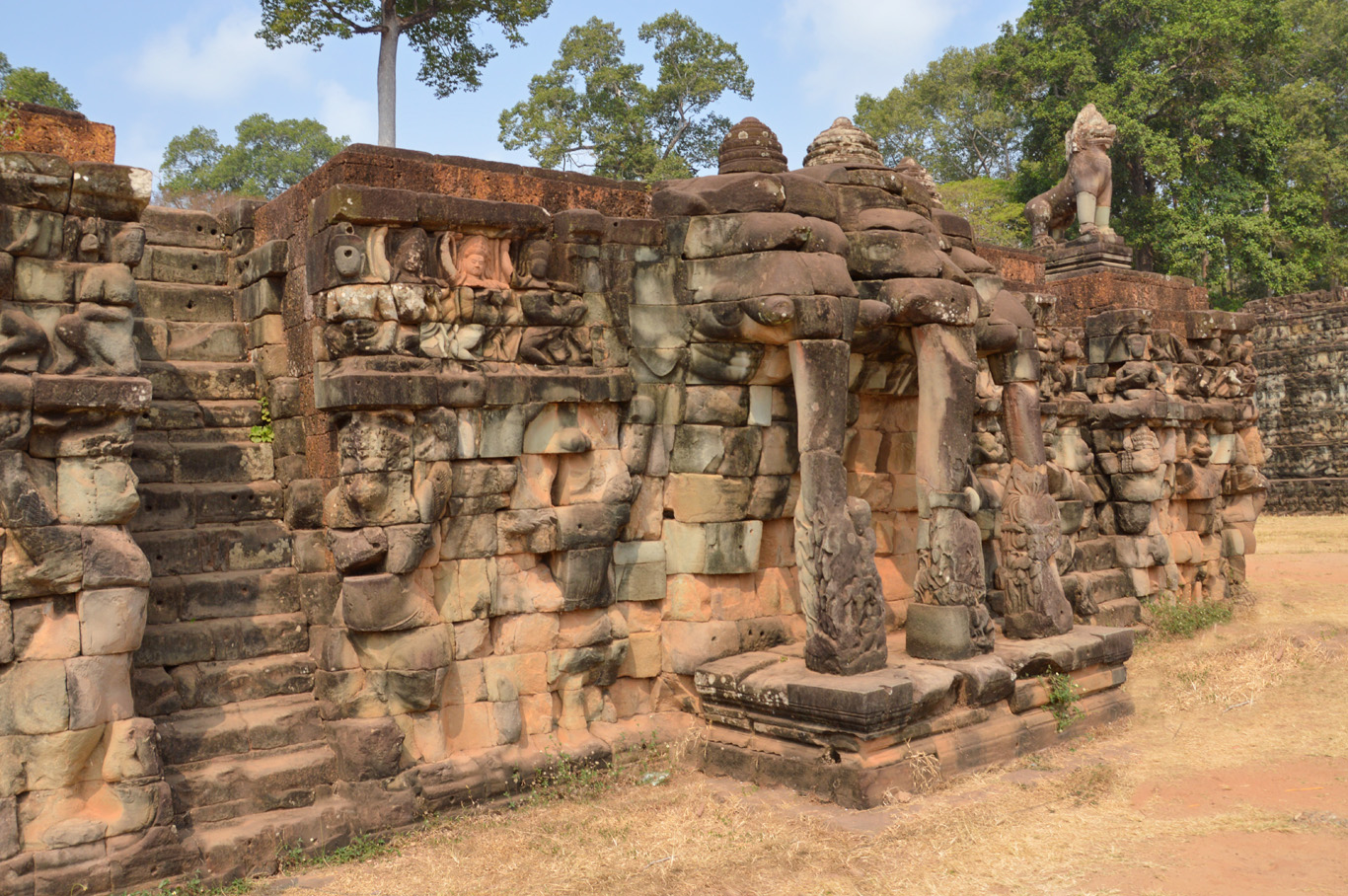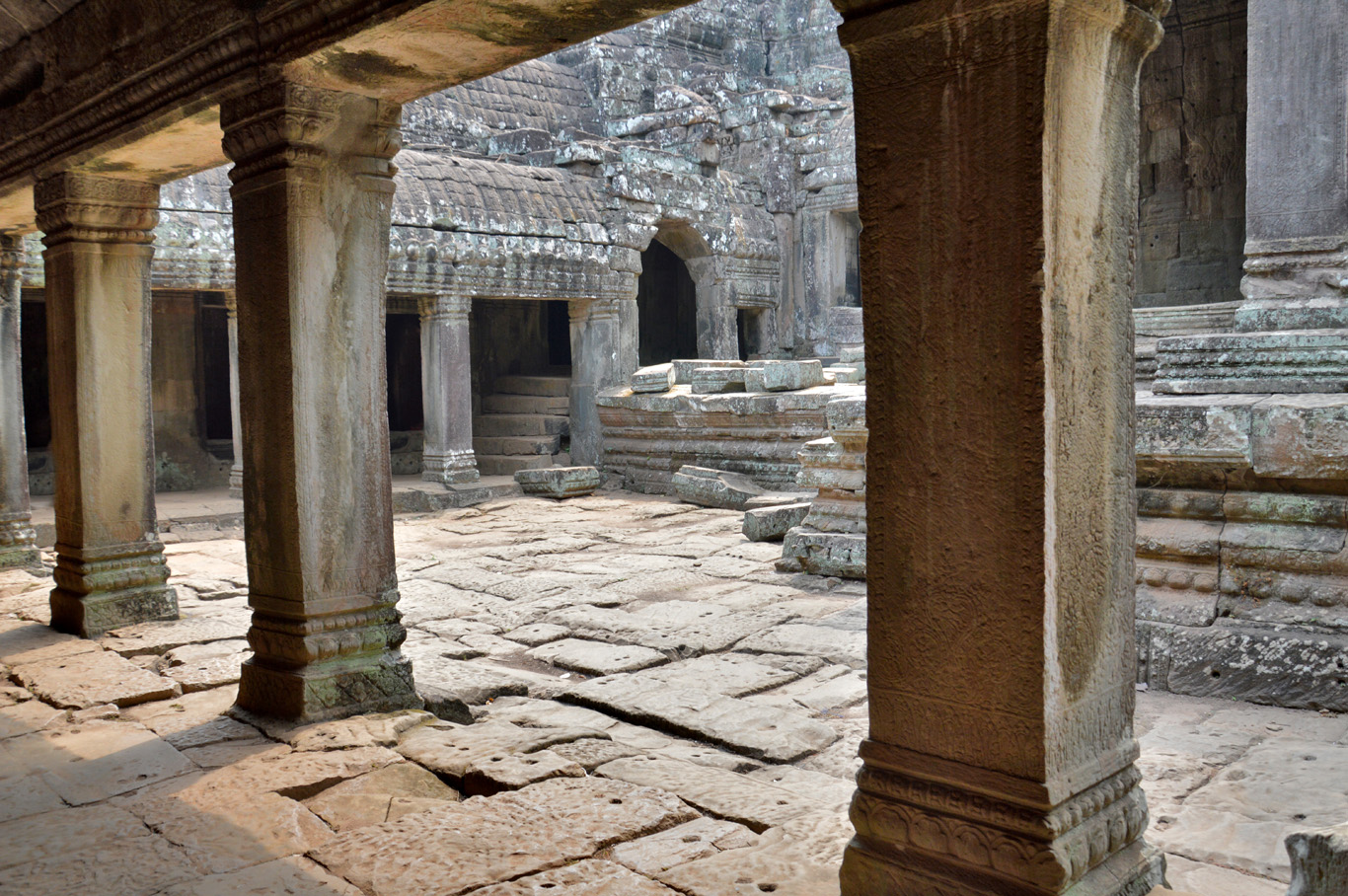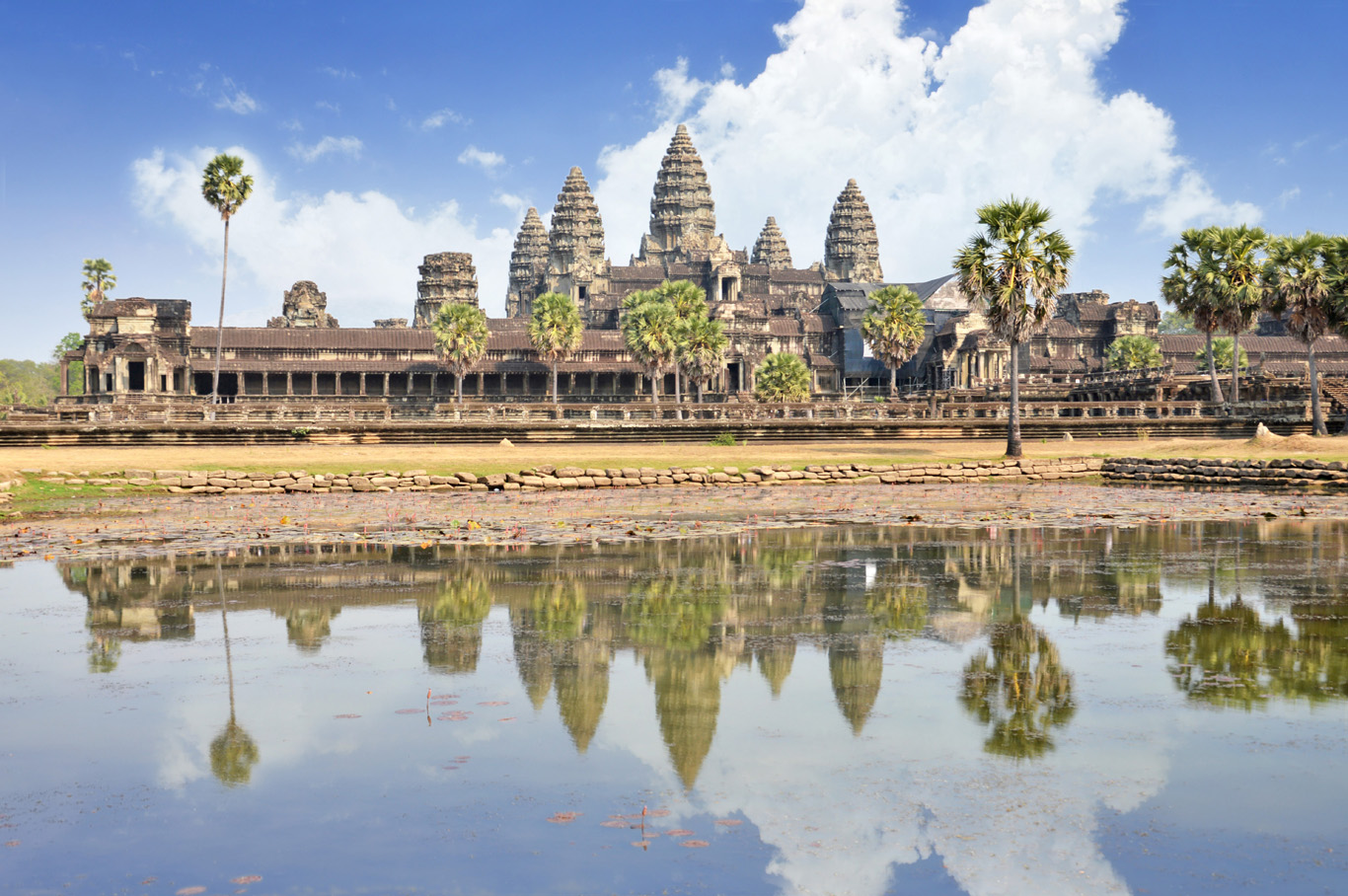Angkor Wat is one of the largest and most impressive temple complexes on Earth. It's also one of world's most famous historical sites - it's visited by literally millions of tourists every year. I prefer more, to be honest, the hidden and unpopular places skipped by everyone, like for example the regions of Caucasus and Central Asia which, although possess everything a perfect tourist destination should have: ancient civilization history, spectacular, diverse landscapes, oriental towns, beautiful seaside and friendly locals; are completely free of western visitors. But I also love historical and archaeological sites so I decided (persuaded by my friends into visiting South-East Asia), why not to see what Angkor Wat is really like. After all the excitement I'd had about Thailand was shattered by the endless scams (especially in Bangkok - read my story here), I was pretty skeptical about Cambodia. But even though I fell victim to a few dishonest people in Siem Reap, I enjoyed Angkor Wat more than any of Thai religious sites, although they were also exceptionally impressive. The sheer size, grandeur and sophistication of Cambodia's main landmark easily compares to the absolutely most magnificent places on our planet like Machu Picchu in Peru, Pompeii and Herculaneum in Italy or Bagan in Myanmar.
How to organize a tour around Angkor Wat and avoid the scams
Right after landing in Siem Reap - the town located near the Angkor Wat complex, me and my travel companions were wondering how to get to our guesthouse. The airport transfer cost around 4 USD per person which is quite good, but as it turned out, we were forced to wait for quite a long while before all other passengers were going to be served.
While waiting in the line to get the tickets, a tuk-tuk driver approached us and insisted that he would take us to our destination quickly and right away for the same price. He seemed very nice and polite so we agreed.
On the way to the hotel, the driver offered us a day tour by tuk-tuk around all the most important sights and temples at Angkor Wat. He said he would charge us 30 USD per person. We bargained and he lowered the price to 25 USD per person (75 USD for 3 people) claiming that this was the best deal we could get anywhere. We agreed to meet him the next morning.
From Siem Reap, after visiting Angkor Wat, we wanted to travel down south to Cambodian coast to see what it's like for real - comparing to the most popular Thai beaches. Having heard our conversation, the driver offered us help again and took us to the tourist office on the way so we could buy the infamous night bus tickets to Sihanoukville (or Snookyville). (I hadn't had a clue about the bus reputation as I read all the forums and blog posts about it afterwards. 99% of people on those forums claimed they would never embark on such a journey. For us, luckily, the bus trip went without any problems and it was pretty cool! I've described it in more detail in the article about Cambodian capital - Phnom Penh.)
At the tourist office, we were charged 30 USD each for the bus tickets and soon after we arrived at our hotel in Siem Reap. The driver seemed so friendly, it seemed so nice of him to take us to the place where we had purchased the tickets that we decided to give him good tips. At that time we had no clue that the whole excitement would be shattered in just a few minutes.
As it turned out, the horrible experiences in Thailand hadn't taught us anything. With the nice approach of the tuk-tuk driver we naively thought, Cambodia would be different. It seems, however, that in all popular places in South East Asia you must be really careful not to get scammed, shortchanged or tricked.
At the reception, we found out that the guesthouse organized the Angkor Wat tours for 45 USD (for 3 people) and if we wanted to view the famous sunrise and additionally the red-stone temple Banteay Srei which is situated around 20 km/15 miles from the main complex, it would cost 60 USD (20 USD per person). We also learnt it was possible to buy the night bus tickets for 20 USD per person!
You might say - 15 or 30 USD - not much difference, but it's not about the money. It's about honesty.
So, my advice is, unfortunately, you have to be on your guard at all times and not trust anyone. Go, do some research yourself and then buy. I would also recommend to get the Angkor Wat tours at your hotel, not from a random person in the street - I'd read on other blogs that some dishonest people can really scam you - for example take you somewhere far and refuse to bring you back if you don't pay a ridiculous additional fee (something like 100 USD!).
In that case, we decided to call off the next day meeting with the tuk-tuk driver. It was a nightmare, we phoned him and when he heard we didn't want his service anymore, his attitude changed 180 degrees. He started shouting that we had deceived him and he even yelled at the receptionist in the hotel that it was all her fault. We didn't care if it was or wasn't honest towards him - he obviously weren't honest with us. Fortunately, we never met him afterwards. And, luckily that was the last problem we encountered in Angkor Wat or Siem Reap and the following days were much more enjoyable.
Ruins of Banteay Srei
Banteay Srei
Banteay Srei
Carvings at Banteay Srei
Banteay Srei
Banteay Srei
Banteay Srei
Banteay Srei - the crowds of tourists
Visiting The Angkor Wat Complex - The Most Important Temples
We decided to get the hotel tuk-tuk tour including the sunrise and the red sandstone Banteay Srei Temple. The tour began at around 5 am, and surprisingly for that part of the world, it was a quite chilly morning. It took around 30 minutes to get to the gate of the Angkor Wat Archaeological Park, where you have to stay another 30 minutes in the line (there's literally thousands of people) and pay 20 USD fee for one day access.
Cambodia is, I think, the only country that I've traveled to where it's cheaper to pay in US dollars (the prices are lower in USD) than in local currency!
We foolishly had exchanged the US dollars into the local currency and, of course, we overpaid! So keep your dollars on you, don't change it!
3 -day pass costs 40 USD and 60 USD for 7 consecutive days - to be honest one day is more than enough for an ordinary person as you will be visiting similar structures all day long - it's enough to see the most impressive and important temples. It makes sense to get the longer pass only if you are a professional photographer or extremely interested in the history of each and every temple.
Sunrise AT ANGKOR WAT
You can admire the sun rising from behind the most impressive temples of all - Angkor Wat. However, the sky that day wasn't clear and it was nothing that special to be honest. I liked the Angkor Wat later, during the day more. Not too mention the crowds of people - it's unbelievable. If you wish to open your tripod and put it on the ground - get there early because later you'll have no chance to find a good spot for a photo! At that point I got so disappointed thinking that it's not a pleasure at all to visit an archaeological site among such swarms of tourists!
Most of the people who were taking photos of the sunrise headed straight back to the Angkor Wat temple but our guide advised us otherwise. He said we should visit the red temple -Banteay Srei - first and then come back in the afternoon to see all the rest when the crowds disperse. It was a great idea.
Banteay Srei Temple
This temple is not located within the strict area of the Angkor Wat Archaeological Park - it was erected in the 10th century around 15 km/25 miles away from the center of the complex. It's dedicated to the Hindu god Shiva. It's different from the other constructions and pretty unique in the sense that it's made of red sandstone. Also, like the other temples it is lavishly decorated in beautifully carved reliefs, sculptures and statues. It's pretty small and literally crowded with people. Sometimes you have to wait in the line to pass to other parts of the monument. However, it is really worth seeing.
Angkor Thom
After visiting Banteay Srei, we headed back to Angkor Wat. The whole complex itself is so large and particular temples are so far away from one another that there's no way you can walk around it. That's why the tuk-tuk tours are so popular.
Now, on the way back we were to see the most important temples before heading on to the main and the most impressive - Angkor Wat itself. So the next stop was Angkor Thom - another sub-complex within the archaeological park. It used to be the capital of the Khmer Empire in the 12th century. The temples within the walls (note the famous Terrace of The Elephants) are unbelievably amazing. From now on you'll be able to really admire and appreciate the sheer size and grandeur of the area. The crowds seemed to completely disappear - dispersed within such a huge area.
Here are some of the most beautiful temples within the walls of Angkor Thom: Phimeanakas - a 10th century Hindu temple which also has the reddish hue due to the red sandstone. It's shape is similar to the pyramids of Inca or Maya Empires in South America. It's pretty spectacular but not as large as the other constructions within Angkor Thom. There used to be a non-existent today tower on top of the building during the time of the Khmer Empire. Baphuon - an 11th century temple dedicated to Hindu god Shiva (later converted into a Buddhist temple). It's larger, more impressive than Phimeanakas, but the color is darker, nearly black. You can climb the 32-meter/100 ft. construction and admire the beautiful, symmetrical walls and other structures below it.
Bayon is the most impressive (12th century) temple of Angkor Thom. It's enormous in size, dark in color and absolutely magnificent. You can walk through the narrow corridors between different rooms and passages and feel just like in a Tomb Rider. Not to mention the sculptures, columns and the exceptional, gargantuan pillars holding spectacular reliefs of faces looking in all four directions. An absolute must while visiting Angkor Wat!
Ta Phrom
Once we visited the impressive Angkor Thom, we headed to the opposite side of the Siem Reap river to see the 12th century Ta Phrom Temple. If, after visiting Bayon you think it can't get better - now your jaw will surely drop.
Ta Phrom is not the largest or the most beautifully decorated. But the way it is slowly engulfed by nature is undoubtedly sensational. The roots and branches of the trees grow through the ancient passages, columns and walls. It's a dramatic sight to experience firsthand how such a masterpiece of human mind and labor is giving in to the power of the jungle.
As an interesting fact, if you want to explore more of the places of this sort that are slowly being taken over by nature - visit Chernobyl in Ukraine. It's a great example of what would happen if all the people in one of our modern cities simply disappeared overnight. You can read my story and browse some exciting and scary photos here.
Banteay Kdei
Banteay Kdei is a 13th century temple located very near Ta Phrom. It's smaller, not as impressive as the main temples with Angkor Wat Archaeological park. If you don't have too much time or you're tired by the heat, you can skip it as it's nothing that you wouldn't have seen before. Now, ahead of us, there was the best sight of all we'd seen during the tour - the Angkor Wat Temple.
Angkor Thom - The terrace of the elephants
The walls of Angkor Thom
Phimenakas Temple
The ruins of the walls of Angkor Thom
Baphoun Temple
Columns at Baphoun Temple
View from the top of Baphoun Temple
Entering the Baphoun Temple
Bayon Temple
Buddha statue at Bayon
Relief at Bayon
Bayon
The famous faces at Bayon
Bayon
Ta Phrom Temple
Tradition and modernity - a monk with a smartphone at Ta Phrom
Sculpture surrounded by the branches - at Ta Phrom
Banteay Kdei
Entrance to ta Phrom Temple
Angkor Wat
Angkor Wat (meaning City of Temples) was the last temple we visited. When you stand face to face with the majesty of this monumental structure, all the other temples might seem to pale in comparison.
Angkor Wat was erected as a Hindu temple dedicated to Vishnu. It served as the center of the Khmer Empire in the 12th century. Later on, similarly to other temples it was converted to a Buddhist one. The complex was the most important religious site of the region as well as a significant place for royalty. It's probably one of the most known South-East Asian monuments and appears on the national flag of Cambodia.
Angkor Wat is the most visited and crowded temple within the whole archaeological park, however, due to its size, similarly to Angkor Thom, during the day the crowds are not as bothering as in the morning -at the sunrise.
The pond just in front of the main gate creates a spectacular view reflecting the towers of Angkor Wat in its surface. When you enter the site, you'll be astonished by all the substructures, pillars and sculptures. The whole temple stands on a few different levels and you can get onto each of them. The views are breathtaking.
The whole site is so magical and magnificent that all the bad experiences that we'd had in Cambodia, vanished in an instant. One of the most impressive ancient ruins on the planet.
Sunset at angkor wat
Our tour also included the sunset viewed from the nearby hill - Bakheng. To get to the top, you must hike for around 30 minutes. I have no idea why this place is so popular with the sunset as you can see nothing from there - no Angkor Wat, no temples - just the trees and bushes. It's just a normal sunset as anywhere else. Not too mention the crowds of people - so many of them that it's nearly impossible to sit down and enjoy. We decided not to even wait for the sunset as there was no point, the view was nothing special or extraordinary. This was the only disappointing part of the tour, but after what we'd experienced earlier, it didn't really matter. Angkor Wat still remains my favorite part of South-East Asia!
This is the photo of the sunrise at Angkor Wat...
...and this is how many people gather
The Angkor Wat Temple complex
Angkor Wat and Siem Reap river
Angkor Wat
Relief at Angkor Wat
The highest level at Angkor Wat
View from the top
At the top of Angkor Wat
Related Posts
Copying without permission is not allowed. If you wish to use any of the site's content (photos or text) or work with us, please contact us.
We welcome questions, advice, support or criticism. However, spam comments will be removed.











































